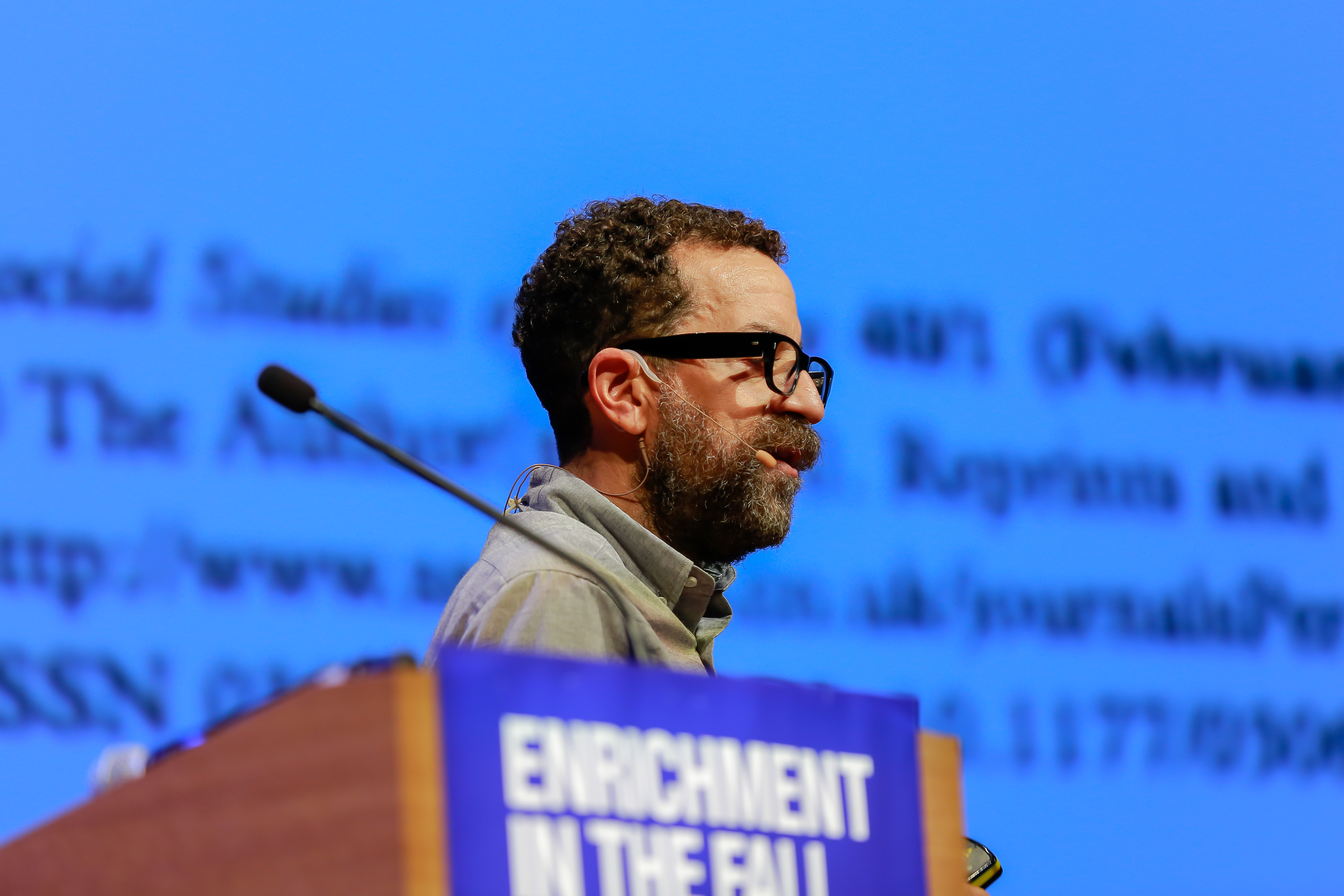The future—with a twist

Designer, engineer and co-creator of the Near Future Laboratory Julian Bleecker speaks during Enrichment in the Fall 2017 on the KAUST campus. Photo by Asharaf Kannearil.
As a child, Julian Bleecker dreamed of owning a copy of the 1975 "'Star Trek' Star Fleet Technical Manual" by American technical illustrator Franz Joseph.
“The manual was completely outside of the 'Star Trek' production, but it meticulously detailed how to build everything shown in the series—Joseph’s level of imagination was genius,” Bleecker said during his KAUST Enrichment in the Fall keynote lecture on October 23. “I thought if I owned the manual, I could learn how to build this stuff. It made me want to become an engineer.”
Engineer and designer Bleecker uses his technical training and curious mind as one of the four members of the Near Future Laboratory, an organization that "explores futures, charts the unexpected and transforms opportunities into new and tangible forms," he explained.
He and his three colleagues—designer Nick Foster; researcher and engineer Fabien Girardin; and researcher and writer Nicolas Nova—"focus on hands-on design, physical construction, prototyping, observation, prop-making and designed science fiction as a way to raise questions, reveal hidden insights and yield innovations that lead to design," Bleecker said. "We believe design makes the world a more habitable, playful place."
Telling the tale
Bleecker's keynote focused on "design fiction," a method of storytelling that uses narrator-driven tales to present possible near future prototypes, suspending the audience's disbelief about the future.
In their lab—which is actually a studio or design practice—the four come together to develop projects inspired by their own interests or desires to see something new in the world.
"Design fiction is our approach to imagining the future—it's a way of building things and making things through fiction, which is a fantastic way to think, evolve and develop ideas," Bleecker said. "We create things that don't exist but they might—they are not quite true but not quite false, and they have the potential to insert themselves into possible futures."

Designer, engineer and co-creator of the Near Future Laboratory Julian Bleecker (center) gave a keynote lecture during Enrichment in the Fall 2017 on the KAUST campus. Here, he receives thanks at the end of his talk from KAUST Professor Gilles Lubineau (left), chair of Enrichment in the Fall, and Marie-Laure Boulot (right), manager of Enrichment Programs. Photo by Asharaf Kannearil.
In "Jurassic Park," for example, viewers are led on a science fiction journey of creating dinosaurs. Through this journey, the audience "stops disbelieving that dinosaurs are actually possible. Scientists are now arguing whether the science presented in the film could be carried out—they're arguing about science fiction, which is actually wonderful," Bleecker said.
Technology's imperfections
Bleecker and team also do design fiction through film, creating a number of short videos that deal with possible future technologies and their roles in our lives.
In one video, a young woman struggles with her smart car's facial recognition system because her makeup is different from when she set up the car. The car's voice dialing phone system also fails due to her pronunciation not matching the internal computer's programming.
"People tend to imagine technology being completely perfect, but it's not and won't be. Sharing the points of failure makes the technology and the future more believable," Bleecker said.
Franz Joseph's "'Star Trek' Star Fleet Technical Manual" also falls under the design fiction umbrella, making science fiction tangible and "shaping, informing and expanding imaginations to what might be possible," he noted. "It tells the story of the technology and how one might work on it."
One of the lab's most extensive projects was creating a self-driving car quick start guide and accompanying fictional news articles to detail the car's release.
"We and a group of workshop participants created the guide with the understanding that people are fascinated by the cultural phenomenon of self-driving cars," Bleecker said. "Behaviors that don't yet exist will evolve out of this phenomenon."
The guide also recognized that the car "might not be the most perfect thing in the world—there will still be points in the technology where you will trip over something," Bleecker pointed out.
For example, if the car can be programmed to pick up fast food but only has one area where the food is placed, how is it possible to keep a pizza hot and a milkshake cold until delivery?
"Those reflect everyday moments and make things seem a little bit more real," he noted.
Technology's twist

Designer, engineer and co-creator of the Near Future Laboratory Julian Bleecker speaks during Enrichment in the Fall 2017 on the KAUST campus. Photo by Asharaf Kannearil.
"We felt the IKEA catalog was a design fiction artifact for its compelling ways to represent normal, ordinary, everyday life in many parts of the world. It's a container of life's essentials and accessories that can be extrapolated from today's normal into tomorrow's normal," he said.
"The work the catalog does—like all design fictions—is to encourage conversations about the kind of near futures we'd prefer, even if that requires us to represent near futures we fear," Bleecker concluded. "In all our work, we take today and project it into the future, but with just a little added twist."
-By Caitlin Clark, KAUST News

